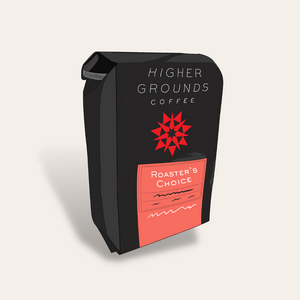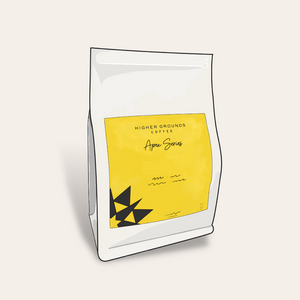Coffee roasting is a delicate art and a complex science. Over the past decade plus, we’ve grown from two people using a borrowed roaster and packaging coffee in a basement into a full-blown roaster-retailer with a team of 20 who work tirelessly to share our farming partners’ exceptional coffee with the world. In the past few years, we’ve expanded our menu from year-round signature blends and single origins to include our Apex Series, representing limited-release coffees at peak quality. Our roasting repertoire has grown as well, including a very wide range of roast profiles from light to dark.
One of our darkest coffees is our French Roast, which has typically been differentiated from other offerings by a hotter final drop temperature (the temperature at which coffee is “dropped” out of the roaster and begins to cool) as well as a longer total roasting duration. There is no one official definition of “French” among specialty coffee professionals, though most say that a French Roast should be created by letting a coffee stay in the roaster past second crack.
So what’s second crack, and what should a good French Roast taste like?
First, let’s back up a bit and take a closer look at few of the distinct markers along the roasting process (thanks to SweetMaria’s for the breakdown):
- In the first few minutes that green (raw) coffee is in the roaster, the beans stay mostly green and then turn a light yellow color, giving off a grassy aroma.
- As the water inside each bean dissipates due to the dry heat, the beans begin to steam.
- FIRST CRACK. At this point the steam becomes fragrant and the bean pushes out significant moisture—kind of like popcorn popping, though less explosive. This benchmark is an audible one, detectable from nearby the roasting machine. First crack is where flavor development begins, when sugars start to caramelize, additional moisture content evaporates, the bean’s structure breaks down, and oils migrate towards the surface of the bean.
- FIRST ROASTED STAGE. At this point the roast can be considered complete, depending upon personal taste and what is intended for a particular coffee.
- The sugars inside the bean continue to caramelize, oils keep moving outward, and the bean expands in size as the roast progresses. There is a sweet spot for many coffees around this benchmark, when sweetness is fully developed but oils are not burned. Past this stage, flavors developed by the roasting process (dry distillation and sugar browning) begin to compete with the inherent characteristics of the bean.
- SECOND CRACK. The majority of the bean’s remaining moisture escapes, and a second audible crack can be heard as its cellular matrix fractures. At second crack, the roast character definitely edges out the origin character. If the beans stay in the roaster much past this point, they can begin to blow apart like shrapnel.
- DARKENING ROAST. The smoke produced in the roasting process becomes very pungent as the sugars burn and the bean structure breaks down even further. Most “French roast” coffees are roasted fully into second crack.
- TOO LATE! If the beans remain in the roaster past this point, the sugars are completely burned, and the result is a thin-bodied, ashy, charcoal-laden cup.
Our French Roast is dropped just past second crack. But why? you might ask. You just said that most roasters take French all the way into second crack. But we’re not a fan of burnt sugars and smoky oils. We want a French that hits the point of subtle smokiness without completely destroying origin characteristics, and we don’t want to risk a thin-bodied cup.
One theory goes that the term “French roast” originated from an old French solution to coffees that were sub-par, having lost freshness and flavor during the long shipment across the ocean: they’d roast the coffee until the stale, funky, objectionable flavors were burned away, leaving a homogenous smoky bean. Whether that’s true or not, it’s certainly possible to take five (or ten, or fifteen) different coffees from around the world, with dynamic differences in character and nuance, roast them all separately well into second crack, line them all up as brewed coffee, and taste barely any difference. Super dark roasts destroy those nuances, and upon brewing, are also lighter in body—counterintuitive though it may seem—because more of the bean’s mass has been roasted away, and soluble solids have been burned out.
However, we understand that not everyone enjoys the delicate subtleties of a light roasted coffee. We know that many coffee drinkers are accustomed to coffee that tastes smoky and bitter and have developed a preference for that profile. So our approach is to strike a balance, offering a wide range of roast profiles to please a variety of palates. We know it’s important for us to offer a French roast as well as other coffees on the darker side of the spectrum. And we choose to approach our French in particular with that balance in mind, fully caramelizing a coffee’s sugars. Our French is in the dark roast category without us having to risk a visit from the fire department.
We’ve had some customers comment about the lack of oil on the surface of our French roast beans. Freshly-roasted beans are still holding tightly to their oils, tucked beneath the surface, and the oily sheen—particularly of darker roasts—will increase over time as the beans rest and de-gas, pushing those oils out to the surface. When you purchase fresh dark-roasted beans, they should not be oily right away, but as they sit for several days, they’ll start to develop that glossy sheen—an indicator of age more than anything else. If that oil is what you love about coffee, we suggest you let your beans rest a few weeks before using them.
If you'd like to try our absolute darkest roast, go for Typhoon Espresso Blend.



